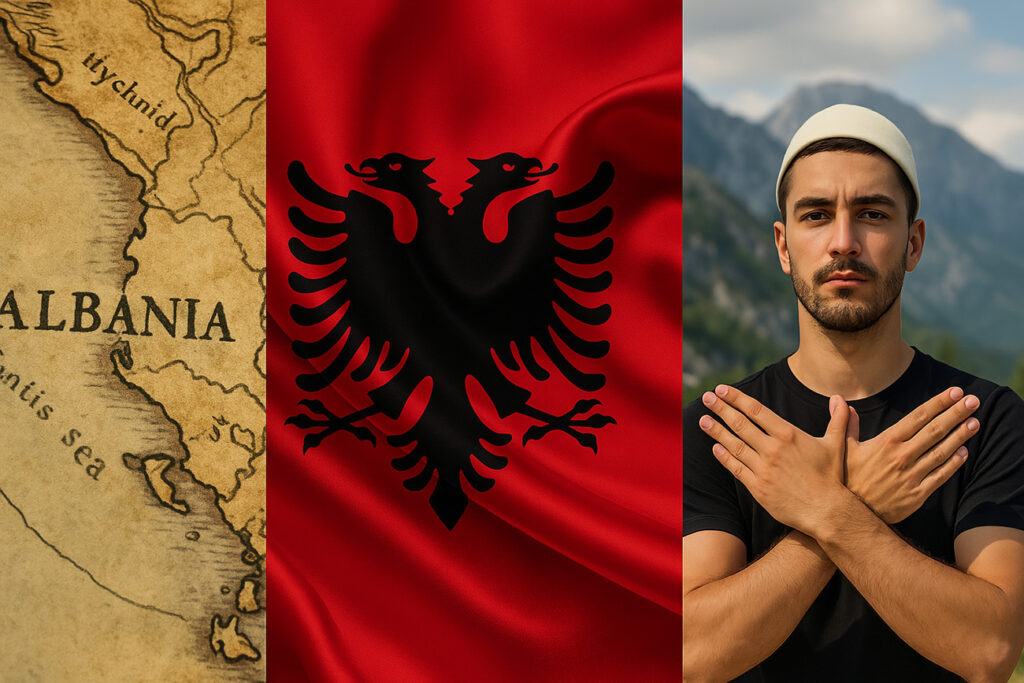
Albanian Pastiçe: Easy baked pasta recipe
Discover Albanian pastiçe: bucatini with feta and eggs baked into a golden pie—simple, nourishing and perfect for hectic days.
Albania is a nation with a distinct and layered identity, grounded in history, language, symbolism, and an enduring sense of pride. Once one of Europe’s most closed-off countries, it’s now steadily emerging as a destination with deep cultural roots — revealed in its name, flag, language, and the striking image of the eagle.

The name “Albania” as we know it today traces back to the Illyrian tribe Albanoi, recorded by the Greek geographer Ptolemy in the 2nd century AD. The Romans adopted the term, and over time it was preserved in various languages.
Some linguists tie the name to the Latin “albus” and Ancient Greek “alphós” — both meaning “white.” This might hint at the snow-capped peaks found inland, like those of the Albanian Alps.
Albanians refer to their homeland as Shqipëri (or Shqipëria), which is commonly translated as “Land of the Eagle.” The word “shqiponjë” means eagle, and Shqiptarë refers to the people — who carry that title with immense pride.
The eagle is deeply embedded in the Albanian identity, not just as a national icon, but also as a symbol of ethnic unity, freedom, and resilience.
With around 7.5 million speakers globally, Albanian stands as a unique branch within the Indo-European language family. It bears no close relation to other modern languages and evolved from ancient Illyrian, spoken in the Balkans before Roman times.
This rare linguistic lineage underscores the cultural uniqueness of the Albanian people – playing a key role in shaping their national identity.
Albania’s flag features a black double-headed eagle on a deep red backdrop. The red reflects courage, sacrifice, and the fight for freedom, while the black signifies strength and determination.
This emblem was first used by Gjergj Kastrioti Skanderbeg, Albania’s national hero. In the 15th century, he led the resistance against the Ottomans. His title, Skënderbeu, comes from the Ottoman İskender Bey — meaning “Lord Alexander” — a name given to him during his earlier service under the sultan.
His personal crest — the double-headed eagle — eventually became the country’s national symbol. The two eagle heads don’t stand for east and west, but rather north and south — a nod to unity across the nation.
A powerful visual emblem of Albanian heritage is the well-known eagle hand gesture. Hands are crossed at the wrists, thumbs linked, and fingers spread like wings – echoing the double-headed eagle seen on the flag.
It’s proudly displayed during national celebrations, sports events, and by Albanians across the globe — a sign of identity, unity, and pride in their roots.
Albania is so much more than just a flag with striking colors. It’s a place where a unique language, proud history, and rich heritage all come together — embodied in the powerful figure of the shqiponja, the eagle.
To grasp the meaning behind these symbols is to understand how deeply Albanian identity is rooted in freedom, pride, and tradition.
✨ And for those who truly want a taste of Albanian culture — you can do that quite literally, with our pure, Authentic Extra Virgin Olive Oil straight from Albanian soil. 🇦🇱🫒
Want to dive deeper into Albania’s history, the meaning of its name, its flag, and national hero Skanderbeg?
Read the full article here:
👉 Prince Skanderbeg – The National Hero of Albania
Pure, simple, and powerful — just like the herbs from the mountains.
Discover our selection of Albanian sea salt and extra virgin olive oil below: natural products with true character.

Discover Albanian pastiçe: bucatini with feta and eggs baked into a golden pie—simple, nourishing and perfect for hectic days.

The flag of Albania is more than just red and black. This article explores the deeper meaning behind its national symbols – from the double-headed eagle to the traditional ‘Shqiponja’ hand gesture, the unique Albanian language, and the country’s rich cultural heritage. A story of pride, identity, and history captured in one powerful symbol.

This homemade chili oil with Extra Virgin olive oil is a flavor bomb that’s also great for your health. Easy to make and incredibly versatile.

Albania is home to thousands of medicinal plants. Discover how traditional herbal wisdom not only impacts lives, but also shapes a unique export industry.

Despite an increase in risk factors such as an unhealthy diet and less physical activity, cardiovascular mortality in Spain remains surprisingly low. What explains this mysterious ‘Spanish Paradox’? Discover how a key element of the Mediterranean diet plays a crucial role.

The Albanian olive harvest is severely impacted by a labor shortage, leading to a significant decline in olive oil production and exports. In the first nine months of 2024, exports dropped by 60% compared to the same period in 2023. This not only poses challenges for the domestic market but also hinders Albania’s position as an emerging olive oil producer.
Subscribe to be inspired with our latest products, deals, taste combinations and much more!